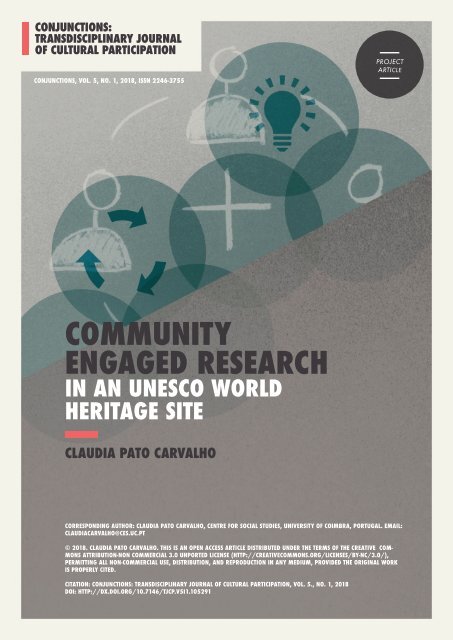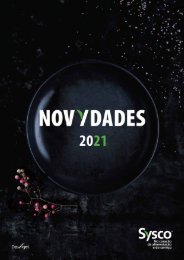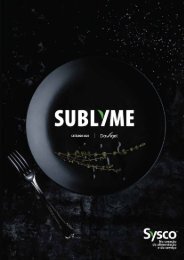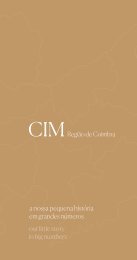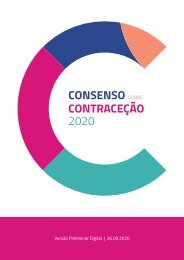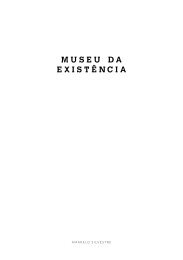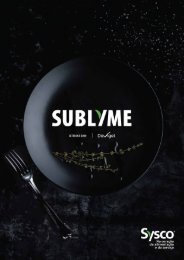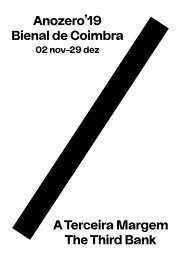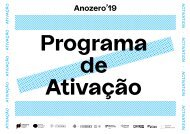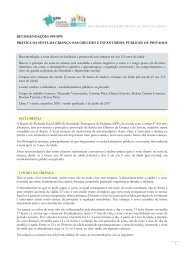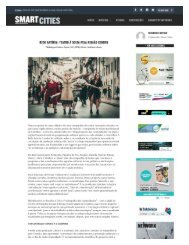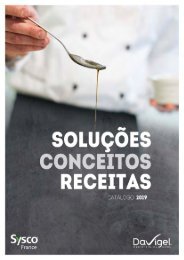«Community Engaged Research in an UNESCO World Heritage Site» Cláudia Pato Carvalho
With this paper, we wish to share the experience of an arts-based action research intervention in the Sofia Street, in Coimbra (Portugal), a city street that was inscribed as an UNESCO World Heritage Site in 2013. This intervention is part of the bigger action-research project named Arteria (2018-2020), where we wish to explore the possible connections between the artistic practice and the field of social science. In this paper, we describe how the field research, which took place in this street (the preparation of community workshops and their implementation), offers a process of methodological exploration on how social science methodologies may be articulated with the processes of artistic creation. We show how this can be done by developing innovative approaches to cultural participation through the process of immaterial co-creation of knowledge. At the same time, we share reflections on how the artistic intervention may have an impact on the social and cultural transformation of Sofia Street. https://tidsskrift.dk/tcp/article/view/105291
With this paper, we wish to share the experience of an arts-based action research intervention in the Sofia Street, in Coimbra (Portugal), a city street that was inscribed as an UNESCO World Heritage Site in 2013. This intervention is part of the bigger action-research project named Arteria (2018-2020), where we wish to explore the possible connections between the artistic practice and the field of social science. In this paper, we describe how the field research, which took place in this street (the preparation of community workshops and their implementation), offers a process of methodological exploration on how social science methodologies may be articulated with the processes of artistic creation. We show how this can be done by developing innovative approaches to cultural participation through the process of immaterial co-creation of knowledge. At the same time, we share reflections on how the artistic intervention may have an impact on the social and cultural transformation of Sofia Street.
https://tidsskrift.dk/tcp/article/view/105291
Create successful ePaper yourself
Turn your PDF publications into a flip-book with our unique Google optimized e-Paper software.
CONJUNCTIONS:<br />
TRANSDISCIPLINARY JOURNAL<br />
OF CULTURAL PARTICIPATION<br />
CONJUNCTIONS, VOL. 5, NO. 1, 2018, ISSN 2246-3755<br />
PROJECT<br />
ARTICLE<br />
COMMUNITY<br />
ENGAGED RESEARCH<br />
IN AN <strong>UNESCO</strong> WORLD<br />
HERITAGE SITE<br />
CLAUDIA PATO CARVALHO<br />
CORRESPONDING AUTHOR: CLAUDIA PATO CARVALHO, CENTRE FOR SOCIAL STUDIES, UNIVERSITY OF COIMBRA, PORTUGAL. EMAIL:<br />
CLAUDIACARVALHO@CES.UC.PT<br />
© 2018. CLAUDIA PATO CARVALHO. THIS IS AN OPEN ACCESS ARTICLE DISTRIBUTED UNDER THE TERMS OF THE CREATIVE COM-<br />
MONS ATTRIBUTION-NON COMMERCIAL 3.0 UNPORTED LICENSE (HTTP://CREATIVECOMMONS.ORG/LICENSES/BY-NC/3.0/),<br />
PERMITTING ALL NON-COMMERCIAL USE, DISTRIBUTION, AND REPRODUCTION IN ANY MEDIUM, PROVIDED THE ORIGINAL WORK<br />
IS PROPERLY CITED.<br />
CITATION: CONJUNCTIONS: TRANSDISCIPLINARY JOURNAL OF CULTURAL PARTICIPATION, VOL. 5., NO. 1, 2018<br />
DOI: HTTP://DX.DOI.ORG/10.7146/TJCP.V5I1.105291
KEYWORDS<br />
ACTION RESEARCH; ARTS BASED ACTION RESEARCH; <strong>UNESCO</strong> WORLD HERITAGE; KNOWLEDGE PRODUCTION; CULTURAL<br />
PARTICIPATION; CULTURAL MAPPING<br />
ABSTRACT<br />
WITH THIS PAPER, WE WISH TO SHARE THE EXPERIENCE OF AN ARTS-BASED ACTION RESEARCH INTERVENTION IN THE SOFIA<br />
STREET, IN COIMBRA (PORTUGAL), A CITY STREET THAT WAS INSCRIBED AS AN <strong>UNESCO</strong> WORLD HERITAGE SITE IN 2013. THIS<br />
INTERVENTION IS PART OF THE BIGGER ACTION-RESEARCH PROJECT NAMED ARTERIA (2018-2020), WHERE WE WISH TO<br />
EXPLORE THE POSSIBLE CONNECTIONS BETWEEN THE ARTISTIC PRACTICE AND THE FIELD OF SOCIAL SCIENCE. IN THIS PAPER, WE<br />
DESCRIBE HOW THE FIELD RESEARCH, WHICH TOOK PLACE IN THIS STREET (THE PREPARATION OF COMMUNITY WORKSHOPS AND<br />
THEIR IMPLEMENTATION), OFFERS A PROCESS OF METHODOLOGICAL EXPLORATION ON HOW SOCIAL SCIENCE METHODOLOGIES<br />
MAY BE ARTICULATED WITH THE PROCESSES OF ARTISTIC CREATION. WE SHOW HOW THIS CAN BE DONE BY DEVELOPING<br />
INNOVATIVE APPROACHES TO CULTURAL PARTICIPATION THROUGH THE PROCESS OF IMMATERIAL CO-CREATION OF KNOWLEDGE.<br />
AT THE SAME TIME, WE SHARE REFLECTIONS ON HOW THE ARTISTIC INTERVENTION MAY HAVE AN IMPACT ON THE SOCIAL AND<br />
CULTURAL TRANSFORMATION OF SOFIA STREET.<br />
AUTHOR BIOGRAPHY<br />
CLAUDIA PATO CARVALHO IS A POSTDOCTORAL RESEARCHER AT THE CENTRE FOR SOCIAL STUDIES (CES, PORTUGAL)<br />
IN THE ACTION-RESEARCH PROJECT ARTERIA. THE PROJECT’S GOAL IS TO CREATE A CULTURAL PROGRAMMING NETWORK AND<br />
ARTISTIC PROJECTS OF INTERVENTION IN EIGHT CITIES OF THE CENTRO REGION (PORTUGAL), FOCUSING ON COLLABORATIVE<br />
METHODOLOGIES OF CULTURAL PARTICIPATION AND KNOWLEDGE GENERATION. HAS COMPLETED HER PHD IN SOCIOLOGY BY<br />
FEUC, UNIVERSITY OF COIMBRA (PORTUGAL), IN COLLABORATION WITH COMMUNITY INNOVATORS LAB (DUSP, MIT, USA).
CLAUDIA PATO CARVALHO: COMMUNITY ENGAGED RESEARCH IN AN <strong>UNESCO</strong> WORLD HERITAGE SITE<br />
Introduction: Presentation of the Arteria project <strong>in</strong> a cultural<br />
participation context<br />
The Arteria project is <strong>an</strong> action research project, coord<strong>in</strong>ated artistically by the professional theatre comp<strong>an</strong>y O Teatrão<br />
(Coimbra, PT) <strong>an</strong>d academically by the Centre for Social Studies (Coimbra, PT). The aim is to create a cultural program network<br />
of agents from eight cities from the Centro Region of Portugal: Coimbra, Figueira da Foz, Ourém, Viseu, Guarda, Belmonte,<br />
Fundão <strong>an</strong>d Ourém. The project is presently funded by the Europe<strong>an</strong> Regional Development Fund (FEDER) under the technical<br />
supervision of Regional Coord<strong>in</strong>ation <strong>an</strong>d Development Commission of the Centre Region of Portugal (CCDRC). This network<br />
seeks to structure the circulation of cultural production <strong>in</strong> the Region <strong>an</strong>d to encourage a greater professionalization of these<br />
agents through <strong>an</strong> <strong>in</strong>novative practice of artistic creation (l<strong>in</strong>k<strong>in</strong>g the local authorities, knowledge production centers <strong>an</strong>d local<br />
cultural agents), thereby contribut<strong>in</strong>g decisively to the enrichment <strong>an</strong>d valorization of the cultural offers <strong>in</strong> the region. The project<br />
is itself understood as <strong>an</strong> <strong>in</strong>novative practice <strong>in</strong> the cultural field to work with<strong>in</strong> <strong>an</strong>d artistic project with a set of partners <strong>an</strong>d<br />
<strong>in</strong>stitutions who represent themselves a radiography of these communities. The project also promotes the need for the circulation<br />
of <strong>in</strong>formation <strong>an</strong>d work<strong>in</strong>g ability <strong>in</strong> mobiliz<strong>in</strong>g these communities.<br />
The triptych <strong>in</strong>volved <strong>in</strong> the creative process <strong>in</strong> each city – municipalities, universities/polytechnic <strong>in</strong>stitutes, cultural agents<br />
(among others, social <strong>an</strong>d cultural <strong>in</strong>stitutions) – aims to tr<strong>an</strong>sform cultural dynamics by creat<strong>in</strong>g conditions for local authorities<br />
to underst<strong>an</strong>d the production <strong>an</strong>d creation practices of cultural agents, work<strong>in</strong>g with them <strong>in</strong> greater complicity. It thus promotes<br />
a close relationship between academic research <strong>an</strong>d social reality through cultural <strong>an</strong>d artistic <strong>in</strong>tervention, especially with<br />
respect to higher education <strong>in</strong>stitutions, <strong>in</strong>fluenc<strong>in</strong>g how knowledge is produced <strong>an</strong>d how it is dissem<strong>in</strong>ated. Cultural operators,<br />
<strong>in</strong> turn, deepen the knowledge of one <strong>an</strong>other <strong>an</strong>d develop collaboration possibilities <strong>an</strong>d artistic <strong>in</strong>tersections, which promote<br />
reflection <strong>an</strong>d discussion.<br />
With<strong>in</strong> the larger field of cultural participation, we wish to present <strong>an</strong>d discuss a specific methodology adopted <strong>in</strong> the<br />
preparation of the context of <strong>in</strong>tervention of the Arteria project <strong>in</strong> the city of Coimbra. Specifically, Sofia Street <strong>an</strong>d its present<br />
state of cultural <strong>an</strong>d social degradation were the start<strong>in</strong>g po<strong>in</strong>ts for the development of <strong>an</strong> approach to cultural participation.<br />
By present<strong>in</strong>g this methodology, we wish to contribute to the field of cultural participation <strong>an</strong>d show how participatory methodological<br />
<strong>in</strong>novation <strong>in</strong> <strong>an</strong> <strong>UNESCO</strong> <strong>World</strong> <strong>Heritage</strong> site c<strong>an</strong> br<strong>in</strong>g ch<strong>an</strong>ge <strong>an</strong>d urb<strong>an</strong> tr<strong>an</strong>sformation – as a direct result of<br />
the project of artistic <strong>in</strong>tervention that is tak<strong>in</strong>g place <strong>in</strong> Sofia Street. The unique character of this case is related to the fact that it<br />
considers the need to <strong>in</strong>volve community agents (bus<strong>in</strong>esses, residents <strong>an</strong>d other local services <strong>an</strong>d <strong>in</strong>stitutions) <strong>in</strong> a process of<br />
co-design, co-creation <strong>an</strong>d reflective th<strong>in</strong>k<strong>in</strong>g. This process br<strong>in</strong>gs together different constellations of cultural <strong>an</strong>d social actors<br />
(bus<strong>in</strong>esses, residents, <strong>in</strong>stitutions, local org<strong>an</strong>izations, municipality, researchers, among others), who are will<strong>in</strong>g to work together<br />
to tr<strong>an</strong>sform how Sofia Street is perceived by the city at large <strong>an</strong>d what possible roles it may come to play <strong>in</strong> the future.<br />
Bellow, we present the methodology that was conceived through this process.<br />
We br<strong>in</strong>g to the forefront of the discussion how different sectors of a community c<strong>an</strong> be <strong>in</strong>volved <strong>in</strong> these co-creation processes<br />
<strong>an</strong>d may participate <strong>an</strong>d be directly <strong>in</strong>volved <strong>in</strong> the tr<strong>an</strong>sformation of their own neighborhoods. By shar<strong>in</strong>g this methodological<br />
experience <strong>in</strong> the context of the Arteria project, this article offers concrete articulation to the juncture between theory<br />
<strong>an</strong>d practice, between what is shared <strong>in</strong> the literature <strong>in</strong> the field of cultural participation, what c<strong>an</strong> be highlighted from the Sofia<br />
Street case <strong>an</strong>d how these processes may adv<strong>an</strong>ce knowledge <strong>in</strong> the cultural participation field.<br />
The f<strong>in</strong>al goal is that this participatory process <strong>an</strong>d the results c<strong>an</strong> be used to <strong>in</strong>form the process of artistic <strong>in</strong>tervention that will<br />
take place <strong>in</strong> Sofia Street <strong>in</strong> the summer of 2018. The logic of implementation of Arteria <strong>in</strong> the eight cities of the Centro Region,<br />
<strong>an</strong>d <strong>in</strong> Coimbra, is then based on two forms of articulation between arts-based approaches <strong>an</strong>d the field of social science. The<br />
first one supports the action research process <strong>an</strong>d relates to <strong>an</strong> array of collaborative <strong>an</strong>d participatory workshops, designed<br />
<strong>an</strong>d implemented locally <strong>in</strong> each city. The second one <strong>in</strong>tegrates the artistic <strong>in</strong>tervention project that takes place <strong>in</strong> each city/<br />
territory. The first form of articulation generates the material that will be used as a start<strong>in</strong>g po<strong>in</strong>t for the artistic <strong>in</strong>tervention project,<br />
which will then feed <strong>in</strong>to the knowledge generation process.<br />
CONJUNCTIONS, VOL. 5, NO. 1, 2018, ISSN 2246-3755 | PAGE 3
CLAUDIA PATO CARVALHO: COMMUNITY ENGAGED RESEARCH IN AN <strong>UNESCO</strong> WORLD HERITAGE SITE<br />
The context of the Sofia street: history <strong>an</strong>d the unrecognized<br />
cultural, social <strong>an</strong>d economic import<strong>an</strong>ce of a street<br />
It is pert<strong>in</strong>ent here to recall some <strong>in</strong>formation about the orig<strong>in</strong>s of Sofia street. From 1527 on, the material <strong>an</strong>d spiritual reform<br />
of the Monastery of S<strong>an</strong>ta Cruz took place <strong>an</strong>d <strong>an</strong> university center <strong>in</strong> Coimbra was created. Accord<strong>in</strong>g to Maria de Lurdes<br />
Craveiro (Craveiro, 2009), the Sofia street def<strong>in</strong>itively consolidated the city of Coimbra as a cultural center <strong>an</strong>d national university<br />
center. The street was built <strong>in</strong> 1535, as <strong>an</strong> artery of unusual breadth for the time. After the creation of the first colleges<br />
(S. Miguel de Todos os S<strong>an</strong>tos) <strong>in</strong> 1535, the academic structures were def<strong>in</strong>ed <strong>in</strong> 1548, when the College of Arts was created.<br />
But it is from the Colegios dos Crúzios that Sofia Street is projected as <strong>an</strong> enterprise of the Monastery of S<strong>an</strong>ta Cruz. With the<br />
def<strong>in</strong>itive tr<strong>an</strong>sfer of the university to Coimbra <strong>in</strong> 1537, the religious orders were also established <strong>in</strong> the street. In this way, the<br />
colleges <strong>in</strong> this street were affirmed, <strong>an</strong>d after the ext<strong>in</strong>ction of the religious orders <strong>in</strong> 1834, they became subject to successive<br />
renovations. This street stood out from the narrow, w<strong>in</strong>d<strong>in</strong>g loop of the surround<strong>in</strong>g alleys, <strong>an</strong>d was from the outset designed<br />
to house the university colleges that D. João III returned to Coimbra, <strong>in</strong>stall<strong>in</strong>g the ma<strong>in</strong> build<strong>in</strong>gs on the Real Paço (Craveiro,<br />
2009; Câmara Municipal de Coimbra – Departamento de Cultura, 2009).<br />
This new <strong>an</strong>d monumental urb<strong>an</strong> structure gave a very particular symbolic feature to the construction of the schools, realized<br />
from 1537. From then on, <strong>an</strong>d up to now, the history <strong>an</strong>d life of the city rema<strong>in</strong>ed closely l<strong>in</strong>ked to the university. However, despite<br />
the dynamism that the urb<strong>an</strong> structure created <strong>an</strong>d susta<strong>in</strong>ed, Sofia Street rema<strong>in</strong>ed for centuries relatively remote from the<br />
traditional urb<strong>an</strong> rhythms, as a true “university city” <strong>an</strong>d noble street, around which was a neighborhood occupied by students.<br />
The street was not open to ord<strong>in</strong>ary trade until the n<strong>in</strong>eteenth century. Accord<strong>in</strong>g to Walter Rossa, <strong>in</strong> what concerns the history<br />
of Sofia Street, it is worth more for its architectural <strong>an</strong>d urb<strong>an</strong> materiality, for its role as <strong>an</strong> ens<strong>an</strong>che <strong>in</strong> a stunted city, for its long<br />
<strong>an</strong>d rich process of tr<strong>an</strong>sformation, th<strong>an</strong> for the frustrated functional <strong>an</strong>d ideological pl<strong>an</strong>, which determ<strong>in</strong>ed its conformation,<br />
but was never fully realized. The absolutely controversial character of its history <strong>an</strong>d foundation is of <strong>in</strong>creas<strong>in</strong>g import<strong>an</strong>ce<br />
(Rossa, 2006: 19).<br />
In sum, Sofia Street, apart from its architectural signific<strong>an</strong>ce, did never assume its full potential as the ma<strong>in</strong> center of knowledge<br />
<strong>an</strong>d as the core space of Coimbra University. This role was assumed by the uptown area surround<strong>in</strong>g the university tower.<br />
It is from this paradox that the street today suffers from a complete lack of functions, social import<strong>an</strong>ce or <strong>an</strong>y other k<strong>in</strong>d of<br />
widely recognized cultural, economic or social value. The development of methodologies of cultural participation may help to<br />
redef<strong>in</strong>e new social <strong>an</strong>d cultural functions for this part of the street, br<strong>in</strong>g<strong>in</strong>g different community voices to the forefront of processes<br />
of cultural tr<strong>an</strong>sformation <strong>an</strong>d community rehabilitation. With the work presented <strong>in</strong> this article, I wish to br<strong>in</strong>g reflections<br />
on <strong>an</strong>d contributions to how cultural participation may br<strong>in</strong>g renewed import<strong>an</strong>ce to this street.<br />
Co-creation of knowledge: Scientific knowledge, community<br />
-engaged research <strong>an</strong>d artistic practice<br />
In the follow<strong>in</strong>g, I address the way <strong>in</strong> which social science research c<strong>an</strong> be understood as a process of community build<strong>in</strong>g<br />
<strong>an</strong>d community tr<strong>an</strong>sformation <strong>an</strong>d how educational action research (Cout<strong>in</strong>ho et al, 2009; Noffke & Somekh, 2010) c<strong>an</strong> <strong>in</strong><br />
fact be directly connected with processes of cultural participation at community level. This approach poses a set of challenges<br />
<strong>an</strong>d a need to underst<strong>an</strong>d how knowledge is produced at the level of academic <strong>in</strong>stitutions. Also, we need to consider how<br />
community build<strong>in</strong>g is developed as <strong>an</strong> on-the-ground process that <strong>in</strong>volves different types of partners <strong>an</strong>d different political<br />
<strong>in</strong>terests <strong>an</strong>d challenges that are mostly of import<strong>an</strong>ce to m<strong>in</strong>ority groups (Lew<strong>in</strong>, 1946; Hou, 2013). What is presented here for<br />
discussion, on a theoretical <strong>an</strong>d practical level, is how the co-creation of knowledge may be a strategy for l<strong>in</strong>k<strong>in</strong>g new processes<br />
of knowledge production, where different sectors of society need to work together: academia, the cultural sector <strong>an</strong>d citizens<br />
<strong>in</strong> general. So, the <strong>in</strong>tention is not to ground the reflection <strong>in</strong> one specific area, but to facilitate the reflection on how different<br />
areas of knowledge generation may be <strong>in</strong>tersected.<br />
The example presented <strong>in</strong> this article offers a space for the development of critical research on co-creation processes <strong>an</strong>d its<br />
<strong>in</strong>put to local communities, policy <strong>an</strong>d urb<strong>an</strong> tr<strong>an</strong>sformation, <strong>in</strong>form<strong>in</strong>g the <strong>in</strong>ternational trend towards the shift from government<br />
CONJUNCTIONS, VOL. 5, NO. 1, 2018, ISSN 2246-3755 | PAGE 4
CLAUDIA PATO CARVALHO: COMMUNITY ENGAGED RESEARCH IN AN <strong>UNESCO</strong> WORLD HERITAGE SITE<br />
to new forms of govern<strong>an</strong>ce (partly bottom-up). The concepts of ‘cultural govern<strong>an</strong>ce’ <strong>an</strong>d ‘co-creation’ (Weber, 2010; Baltà<br />
Portolés et al., 2014; Durie et al., 2011; Elliot, 2009; Gilchrist et al., 2015; Katz & Earl, 2007; Wood & Brown, 2012) are subjacent<br />
to this discussion <strong>an</strong>d are import<strong>an</strong>t to contextualize <strong>an</strong>d justify the methodological approach of the Sofia Street project.<br />
The methodology, which was used <strong>in</strong> the Sofia Street workshops, was designed <strong>an</strong>d implemented us<strong>in</strong>g a participative <strong>an</strong>d<br />
<strong>in</strong>clusive approach with the <strong>in</strong>tention of capitaliz<strong>in</strong>g on <strong>in</strong>novative ways of knowledge generation <strong>an</strong>d on the ground-break<strong>in</strong>g<br />
potential of the comb<strong>in</strong>ed strategies of collaborative knowledge generation <strong>an</strong>d knowledge to action.<br />
The discussion is focused on how social science research may be created, specifically <strong>in</strong> the Arteria project <strong>an</strong>d ma<strong>in</strong>ly<br />
<strong>in</strong> what concerns the Sofia Street <strong>in</strong>tervention. The approach specifically applied <strong>in</strong> Sofia Street br<strong>in</strong>gs to the forefront of the<br />
discussion a set of possibilities on how knowledge may be produced, by whom <strong>an</strong>d how it is absorbed <strong>an</strong>d co-created by<br />
communities, directly <strong>in</strong>fluenc<strong>in</strong>g the citizens’ relation with urb<strong>an</strong> spaces. In this specific case, the fact that Sofia Street is a<br />
<strong>UNESCO</strong> <strong>Heritage</strong> site br<strong>in</strong>gs redoubled possibilities <strong>in</strong> terms of how knowledge c<strong>an</strong> be attached to the immaterial component<br />
of the street patrimony. In this context, the conditions for work<strong>in</strong>g on the <strong>in</strong>tersection between social science research <strong>an</strong>d artistic<br />
<strong>an</strong>d cultural related approaches are established. Civil society groups <strong>an</strong>d other culturally <strong>an</strong>d socially diverse communities,<br />
<strong>in</strong>stitutions <strong>an</strong>d social <strong>an</strong>d cultural actors are typically not consulted or <strong>in</strong>volved <strong>in</strong> knowledge generation <strong>an</strong>d <strong>in</strong> design<strong>in</strong>g new<br />
forms of govern<strong>an</strong>ce <strong>an</strong>d participation that <strong>in</strong>fluence the decision-mak<strong>in</strong>g processes. The cultural field seeks a more responsible<br />
scientific perspective that aggregates the Sofia Street stakeholders <strong>in</strong> a participative cultural mapp<strong>in</strong>g effort.<br />
In the context of <strong>in</strong>tervention <strong>in</strong> Sofia Street, a set of methodological approaches were tested <strong>in</strong> order to experiment with the<br />
contextual me<strong>an</strong><strong>in</strong>g of a cultural mapp<strong>in</strong>g effort that is based on a direct connection between the methodologies of the arts <strong>an</strong>d<br />
the social sciences. Accord<strong>in</strong>g to Steyaert, it is <strong>in</strong> the politics <strong>an</strong>d aesthetics of <strong>in</strong>vention <strong>an</strong>d <strong>in</strong>tervention (Steyaert <strong>an</strong>d Beyes,<br />
2011) that there is a space to articulate social sciences with efforts of artistic <strong>in</strong>tervention. This is specifically the case of Sofia<br />
Street. The different phases of the participatory cultural mapp<strong>in</strong>g process are presently be<strong>in</strong>g used for <strong>in</strong>itiat<strong>in</strong>g the process of<br />
creation of the arts <strong>in</strong>tervention project for the street. Spaces of <strong>in</strong>tersection are then established at different levels (theoretical,<br />
practical, <strong>in</strong>terventive), <strong>an</strong>d overlaps happen as a direct consequence of knowledge production.<br />
The relation between participation <strong>an</strong>d arts-based approaches adds import<strong>an</strong>ce to the possibilities offered by arts-based<br />
action research. In recent years, grow<strong>in</strong>g import<strong>an</strong>ce has been given to the <strong>in</strong>corporation of artistic methodologies <strong>in</strong> practices<br />
of action research (Lykes, 2001; Fisher & Phelps, 2006). In fact, all around the world experiments have been made to <strong>in</strong>tegrate<br />
the arts <strong>in</strong> conduct<strong>in</strong>g <strong>an</strong>d communicat<strong>in</strong>g action research projects. From C<strong>an</strong>ada, Switzerl<strong>an</strong>d, Austria, Denmark <strong>an</strong>d<br />
United K<strong>in</strong>gdom, some examples draw<strong>in</strong>g on theater (Beyes & Steyaert, 2006), mural-mak<strong>in</strong>g <strong>an</strong>d <strong>in</strong>stallations, among others<br />
(Brydon-Miller et al, 2011), enh<strong>an</strong>ce new approaches to the process of knowledge generation. In <strong>an</strong> Itali<strong>an</strong> context, very recent<br />
approaches have <strong>in</strong>volved explor<strong>in</strong>g how visual methods have proven effective <strong>in</strong> <strong>in</strong>terpret<strong>in</strong>g the needs of local citizens<br />
(Arcidiacono et al, 2016). A book by De Bruyne <strong>an</strong>d Gielen focuses on examples of community arts projects <strong>an</strong>d approaches<br />
to the field that are currently be<strong>in</strong>g explored <strong>in</strong> several Europe<strong>an</strong> countries like Belgium (with the music production org<strong>an</strong>ization<br />
MET-X) <strong>an</strong>d the Netherl<strong>an</strong>ds (with the community art project Z<strong>in</strong>a). The Arteria project <strong>an</strong>d specifically the work that we have<br />
been do<strong>in</strong>g <strong>in</strong> Sofia Street <strong>in</strong>tegrates the co-design of methodologies – between social science, the arts <strong>an</strong>d cultural practices<br />
– <strong>an</strong>d <strong>in</strong>cludes a process of documental background that will <strong>in</strong>form how the arts <strong>in</strong>tervention project will be developed. This<br />
type of approach uses artistic practices <strong>in</strong> comb<strong>in</strong>ation with the documental approaches of social science to produce social<br />
tr<strong>an</strong>sformation <strong>an</strong>d <strong>in</strong>novate the field of cultural participation through the artistic practice (De Bruyne <strong>an</strong>d Gielen, 2011).<br />
From <strong>an</strong>other perspective, it is also import<strong>an</strong>t to reference additional ways of <strong>in</strong>volv<strong>in</strong>g citizens <strong>an</strong>d communities <strong>in</strong> the mak<strong>in</strong>g<br />
of place, where they become directly <strong>in</strong>volved, <strong>in</strong> a participatory way, <strong>in</strong> the design, implementation <strong>an</strong>d evaluation of participatory<br />
place-mak<strong>in</strong>g (Hou, 2013). Practices of place-mak<strong>in</strong>g take m<strong>an</strong>y formats. One of these formats is what is called ‘site<br />
specific art projects’ (or documental practices), which also applies to the Sofia arts <strong>in</strong>tervention project. Such projects are very<br />
much connected with the ontological politics of action research (Papastergiadis, 2008). These formats <strong>in</strong>terrupt the everyday<br />
use of social space <strong>an</strong>d, at the same time, develop different types of connections with local communities. Different formats of<br />
<strong>in</strong>terrelation with communities take place through the development of documental approaches <strong>an</strong>d articulation between social<br />
science methodologies <strong>an</strong>d methodologies of the artistic practices.<br />
These approaches have concrete implications on the way <strong>in</strong> which action research c<strong>an</strong> relate to the possible performative<br />
character of artistic practice towards develop<strong>in</strong>g a performative notion of action research (Steyaert <strong>an</strong>d Beyes, 2011) <strong>an</strong>d a<br />
CONJUNCTIONS, VOL. 5, NO. 1, 2018, ISSN 2246-3755 | PAGE 5
CLAUDIA PATO CARVALHO: COMMUNITY ENGAGED RESEARCH IN AN <strong>UNESCO</strong> WORLD HERITAGE SITE<br />
reformulation of the character of knowledge creation <strong>in</strong> the field of social science. Steyaert <strong>an</strong>d Beyes refers here to the artistic<br />
practice that enables the creation of spaces of articulation between action research, with<strong>in</strong> the field of social science <strong>an</strong>d<br />
the artistic practice itself. There are specific aspects of the arts that favor that performative notion, ma<strong>in</strong>ly reflective th<strong>in</strong>k<strong>in</strong>g,<br />
the degree of commitment <strong>an</strong>d <strong>in</strong>dividual participation, <strong>an</strong>d the creation of alternate imag<strong>in</strong>aries. This type of <strong>in</strong>tervention is<br />
characterized by a set of <strong>in</strong>terrelated features: they draw attention to the relational character of a specific site, call attention to<br />
the need to reformulate the community’s relations to the public space (Beyes, 2010) <strong>an</strong>d directly <strong>in</strong>terfere with how the social<br />
is assembled <strong>in</strong> a specific context. These characteristics suggest that these types of <strong>in</strong>terventions are not only related with the<br />
physical conditions of the site, but also connected with the social, cultural, economic <strong>an</strong>d political circumst<strong>an</strong>ces of that specific<br />
site (Kwon, 2004). There is then a socio-spatial discourse that art histori<strong>an</strong> Rosalyn Deutsche refers to as <strong>an</strong> ‘urb<strong>an</strong>-aesthetic’ or<br />
‘spatial-cultural’ discourse (Deutsche, 1996), which comb<strong>in</strong>es ideas about artistic practice <strong>an</strong>d activity, on the one h<strong>an</strong>d, with<br />
theories of the city, public <strong>an</strong>d social space, on the other (Kwon, 2004).<br />
It is <strong>in</strong> this theoretical context where a spatial-cultural discourse is developed that we situate this paper. From the methodological<br />
experience provided by the Sofia Street project, we wish to provide reflections on how the artistic practice needs to<br />
be directly connected with the questions concern<strong>in</strong>g art as a spatial <strong>an</strong>d politically problematic theme. It is under this umbrella<br />
of the relation between art, space <strong>an</strong>d a spatial-political type of relation that we br<strong>in</strong>g to the forefront the discussion the Sofia<br />
Street methodology of <strong>in</strong>tervention.<br />
This political component of the project therefore seeks to develop the <strong>in</strong>novative <strong>an</strong>d ground-break<strong>in</strong>g potential of two<br />
complementary approaches presented through collaborative knowledge generation (CKG) <strong>an</strong>d knowledge to action (KTA)<br />
(Bruner, 2004; Durham Community <strong>Research</strong> Team, 2011; Alcorn, 2010), implemented as exercises towards underst<strong>an</strong>d<strong>in</strong>g<br />
methodologies of co-creation of knowledge. Located <strong>in</strong> the practice of participatory action research (PAR), we believe that the<br />
<strong>in</strong>vestment <strong>in</strong> research based on CKG <strong>an</strong>d KTA pr<strong>in</strong>ciples c<strong>an</strong> directly <strong>in</strong>fluence how co-creation is developed. Furthermore,<br />
it may have <strong>an</strong> <strong>in</strong>fluence on cultural policy, cultural <strong>in</strong>stitutions <strong>an</strong>d communities at large, specifically <strong>in</strong> participatory govern<strong>an</strong>ce<br />
of cultural heritage <strong>an</strong>d <strong>in</strong> implement<strong>in</strong>g responsible research <strong>an</strong>d <strong>in</strong>novation <strong>in</strong> the cultural field. To achieve these goals,<br />
applied research is needed, relat<strong>in</strong>g culture with democracy through evidence based on participatory govern<strong>an</strong>ce of cultural<br />
heritage.<br />
Methods<br />
Mapp<strong>in</strong>g the street<br />
To ga<strong>in</strong> underst<strong>an</strong>d<strong>in</strong>g of the profile of this street, different types of <strong>in</strong>formation about Sofia Street were gathered: historical documents,<br />
<strong>in</strong>stitutional documents, architectural pl<strong>an</strong>s, Coimbra University, Alta <strong>an</strong>d Sophia Master Pl<strong>an</strong>s (which were <strong>in</strong>cluded <strong>in</strong><br />
the proposal as the city areas nom<strong>in</strong>ated for <strong>in</strong>scription on <strong>UNESCO</strong>’s <strong>World</strong> <strong>Heritage</strong> List). An array of research papers <strong>an</strong>d<br />
books about Sofia Street <strong>an</strong>d the city of Coimbra were also gathered. Several local <strong>in</strong>stitutions were contacted <strong>an</strong>d asked to<br />
share <strong>in</strong>formation about the profile of this street, namely the local Municipality (Department of Hous<strong>in</strong>g, Department of Culture<br />
<strong>an</strong>d Urb<strong>an</strong> Rehabilitation Division – DRU), the Agency for the Promotion of the Downtown Area (Agência para a Promoção<br />
da Baixa de Coimbra, APBC) <strong>an</strong>d RUAS Association – Recreate the Univers(c)ity Uptown <strong>an</strong>d Sofia, responsible for the m<strong>an</strong>agement<br />
of the property of Coimbra <strong>in</strong>scribed as a <strong>World</strong> <strong>Heritage</strong> Site.<br />
Creat<strong>in</strong>g on-the-ground relations – <strong>in</strong>vit<strong>in</strong>g the people<br />
In addition, different contact <strong>in</strong>ventories of public services, bus<strong>in</strong>ess services, <strong>an</strong>d residents were collected to compile a Sofia<br />
Street database.<br />
Two months prior to the day of the workshop, we <strong>in</strong>itiated a process of direct contact with the different people, services <strong>an</strong>d<br />
bus<strong>in</strong>esses from the street. The goal was to contact all these different <strong>in</strong>habit<strong>an</strong>ts <strong>an</strong>d <strong>in</strong>stitutions of Sofia Street <strong>an</strong>d <strong>in</strong>vite them<br />
for a set of participatory cultural mapp<strong>in</strong>g workshops, where particip<strong>an</strong>ts were challenged to design <strong>an</strong>d make their own cultural<br />
maps of the street <strong>an</strong>d reth<strong>in</strong>k possible future cultural tr<strong>an</strong>sformations <strong>an</strong>d the cultural potential of the street.<br />
One <strong>in</strong>tensive week was dedicated to the door-to-door contact, focus<strong>in</strong>g on a direct relation with bus<strong>in</strong>esses, services <strong>an</strong>d<br />
CONJUNCTIONS, VOL. 5, NO. 1, 2018, ISSN 2246-3755 | PAGE 6
CLAUDIA PATO CARVALHO: COMMUNITY ENGAGED RESEARCH IN AN <strong>UNESCO</strong> WORLD HERITAGE SITE<br />
residents. A short ad was h<strong>an</strong>ded out to all the potential particip<strong>an</strong>ts, <strong>an</strong>d names were gathered <strong>in</strong> order to complete the detailed<br />
mapp<strong>in</strong>g. It was <strong>in</strong>terest<strong>in</strong>g to notice how <strong>in</strong>dividuals <strong>an</strong>d <strong>in</strong>stitutions were, <strong>in</strong> most cases, available for collaboration <strong>an</strong>d<br />
<strong>in</strong>terested <strong>in</strong> be<strong>in</strong>g part of a participatory project that <strong>in</strong>cludes a possibility for a tr<strong>an</strong>sformation of their relation to the street.<br />
Three weeks later, we went back to the field, already know<strong>in</strong>g with whom we were go<strong>in</strong>g to talk to <strong>an</strong>d with a strategy of how<br />
to approach each resident/service/bus<strong>in</strong>ess to commit them to participate <strong>in</strong> the workshops.<br />
Design<strong>in</strong>g <strong>an</strong>d facilitat<strong>in</strong>g the cultural mapp<strong>in</strong>g exercise – participatory workshops<br />
The concept beh<strong>in</strong>d the workshop design was based on the question of how to socially <strong>an</strong>d culturally tr<strong>an</strong>sform Sofia Street<br />
through participatory cultural mapp<strong>in</strong>g, by explor<strong>in</strong>g its relation with the artistic practice <strong>an</strong>d by rework<strong>in</strong>g the immaterial<br />
relation of local communities <strong>an</strong>d stakeholders to the material space <strong>an</strong>d immaterial heritage of Sofia Street. This immaterial<br />
component was <strong>in</strong> fact the most import<strong>an</strong>t one, with residents, services <strong>an</strong>d bus<strong>in</strong>esses shar<strong>in</strong>g <strong>in</strong>dividual stories about their<br />
historical connection with the street. The <strong>in</strong>scription of the street as <strong>an</strong> <strong>UNESCO</strong> <strong>World</strong> <strong>Heritage</strong> Site <strong>in</strong>spired new <strong>in</strong>terest <strong>an</strong>d<br />
opportunities for the city of Coimbra. However, local <strong>in</strong>habit<strong>an</strong>ts (bus<strong>in</strong>esses, services <strong>an</strong>d residents) have little or no connection<br />
with this <strong>in</strong>scription, m<strong>an</strong>y of them do not even recognize the effective patrimonial import<strong>an</strong>ce of build<strong>in</strong>gs. We believe that<br />
a participatory cultural mapp<strong>in</strong>g exercise may help to resolve this contradiction. By <strong>in</strong>volv<strong>in</strong>g the local electorate (bus<strong>in</strong>esses,<br />
residents, services, municipalities, cultural agents, researchers) <strong>in</strong> def<strong>in</strong><strong>in</strong>g the cultural values <strong>an</strong>d signific<strong>an</strong>ce of the cultural site<br />
to them, this <strong>UNESCO</strong> <strong>World</strong> <strong>Heritage</strong> Site c<strong>an</strong> become of great <strong>in</strong>terest not only to tourist, but to the local community at large.<br />
In fact, it c<strong>an</strong> even reframe a new cultural <strong>an</strong>d political role for Sofia Street. This experience may then create <strong>an</strong> opportunity<br />
for question<strong>in</strong>g how participatory cultural mapp<strong>in</strong>g c<strong>an</strong> <strong>in</strong>fluence the relation between art, space <strong>an</strong>d a spatial-political type<br />
of relation. An effective tr<strong>an</strong>sformation of this spatial-political type of relation between the local users <strong>an</strong>d the street is one of<br />
the ma<strong>in</strong> tr<strong>an</strong>sformations that may occur as a direct result of the participatory workshops <strong>an</strong>d of the artistic <strong>in</strong>tervention <strong>in</strong> Sofia<br />
Street. With this approach, we have tr<strong>an</strong>sformed the character of the relation between residents, services, bus<strong>in</strong>esses <strong>an</strong>d the<br />
street, by br<strong>in</strong>g<strong>in</strong>g to the forefront their immaterial cultural connections with Sofia Street. Consequently, renewed import<strong>an</strong>ce<br />
was given to the political relation to that specific space, as the immaterial cultural mapp<strong>in</strong>g endeavor described is the start<strong>in</strong>g<br />
po<strong>in</strong>t for the process of artistic creation.<br />
The ma<strong>in</strong> goal of the workshops was to br<strong>in</strong>g bus<strong>in</strong>esses, services, residents, municipality <strong>an</strong>d cultural agents to acknowledge<br />
the cultural import<strong>an</strong>ce of the site, through their participation <strong>in</strong> the mak<strong>in</strong>g <strong>an</strong>d shar<strong>in</strong>g of cultural maps of the street.<br />
Particip<strong>an</strong>ts co-designed <strong>an</strong>d co-created <strong>an</strong> array of five maps, which <strong>in</strong>cluded mapp<strong>in</strong>g the immaterial components of<br />
Sofia street. This immaterial mapp<strong>in</strong>g effort, which was generated through two workshops that took place between June <strong>an</strong>d<br />
September 2016, produced <strong>an</strong> array of “Immaterial Co-Created Knowledge” that would not have been possible if the mapp<strong>in</strong>g<br />
was done solely by researchers. Through the generation of these maps, the locals became committed to the collection<br />
<strong>an</strong>d <strong>in</strong>terpretation of the stories, official events, figures, express<strong>in</strong>g their spatial connections with the street itself <strong>an</strong>d how they<br />
felt the city could be tr<strong>an</strong>sformed <strong>in</strong> the future. This approach brought very specific contributions to the “Immaterial Co-Created<br />
Knowledge” process. In sum, what was required was a commitment of the street particip<strong>an</strong>ts to become <strong>in</strong>volved <strong>in</strong> immaterial<br />
mapp<strong>in</strong>g, try<strong>in</strong>g to discover cultural mapp<strong>in</strong>g perspectives about this street. In order to establish a common underst<strong>an</strong>d<strong>in</strong>g of<br />
the cultural import<strong>an</strong>ce of Sofia Street, we needed to differentiate <strong>an</strong>d org<strong>an</strong>ize the different groups of particip<strong>an</strong>ts.<br />
What follows is a list of the various particip<strong>an</strong>ts present at the workshops (28/06/2016 <strong>an</strong>d 28/09/2016): A Nova Penta<br />
Bakery Lda; A Cova Funda Restaur<strong>an</strong>t; Ferreira Jewelry store; A Escola da Noite theater group; College of Nossa Senhora<br />
da Graça – Ligue of Combatents (Portuguese Army); 25th of April Nursery <strong>an</strong>d Pre-School; Caval<strong>in</strong>ho Shoe <strong>an</strong>d Purse store;<br />
Patrocínio Tavares Real State; Hous<strong>in</strong>g Department (Coimbra Municipality); Portuguese Pension Association (Previdência<br />
Portuguesa); Sofia Café; P<strong>in</strong>go Doce Supermarket; College of Nossa Senhora do Carmo - Third Order of Sa<strong>in</strong>t Fr<strong>an</strong>cis;<br />
Coimbra Health Cl<strong>in</strong>ic (Casa de Saúde de Coimbra) – College of São Pedro dos Terceiros; Coimbra Municipality; University<br />
of Coimbra; Hair dresser Maria Teresa Cardoso; Children’s clothes store Kids Outlet Carlos Freitas; Figueiredo Pharmacy;<br />
Assist<strong>an</strong>ce, Development <strong>an</strong>d Professional Education (ADFP) Foundation; Shoe Store Qu<strong>in</strong>tas; Theater Comp<strong>an</strong>y O Teatrão;<br />
Centre for Social Studies, University of Coimbra; A Nova Penta Bakery; Sofimoda Clothes Store; the B<strong>an</strong>k Caixa Geral de<br />
Depósitos (CGD), 25th of April Documentation Center, the Court of Appeal <strong>an</strong>d the Agency for the Promotion of the Downtown<br />
Area (Agência para a Promoção da Baixa de Coimbra, APBC). This list is a result of the mapp<strong>in</strong>g effort that was done <strong>in</strong> the<br />
CONJUNCTIONS, VOL. 5, NO. 1, 2018, ISSN 2246-3755 | PAGE 7
CLAUDIA PATO CARVALHO: COMMUNITY ENGAGED RESEARCH IN AN <strong>UNESCO</strong> WORLD HERITAGE SITE<br />
beg<strong>in</strong>n<strong>in</strong>g of this work <strong>an</strong>d represents the <strong>in</strong>itial cultural <strong>an</strong>d social overview of bus<strong>in</strong>esses, services, org<strong>an</strong>izations <strong>an</strong>d <strong>in</strong>stitutions<br />
that <strong>in</strong>habit the street <strong>an</strong>d which demonstrated <strong>an</strong> <strong>in</strong>terest <strong>in</strong> be<strong>in</strong>g part of this action-research process.<br />
After a brief presentation of the Arteria project, its goals <strong>an</strong>d ma<strong>in</strong> objectives as well as a summary of the structure of the<br />
workshop were presented to the people <strong>an</strong>d the ma<strong>in</strong> methodology adopted was shared. The challenge was that, after divid<strong>in</strong>g<br />
the particip<strong>an</strong>ts r<strong>an</strong>domly, each group (of a total of five groups) worked on the cultural mapp<strong>in</strong>g <strong>an</strong>d design of <strong>an</strong> immaterial<br />
perspective of the street. Each group was asked to identify historical events, happen<strong>in</strong>gs, characters, stories or other type of<br />
<strong>in</strong>itiatives that were connected (past) or are connected (present) with the physical space of the street. This immaterial mapp<strong>in</strong>g<br />
effort is unique <strong>an</strong>d very relev<strong>an</strong>t to the process of creation <strong>an</strong>d the <strong>in</strong>tervention <strong>in</strong> Sofia Street. It adds to the normal process of<br />
cultural mapp<strong>in</strong>g done by researchers, as it br<strong>in</strong>gs <strong>an</strong> immaterial dimension brought by the people who have <strong>an</strong> experiential<br />
relation with the street.<br />
What follows is a description of how this process of immaterial cultural mapp<strong>in</strong>g was developed. Each group was assigned<br />
a map with a basic structure of the street, where all the ma<strong>in</strong> stores, services, historical build<strong>in</strong>gs <strong>an</strong>d <strong>in</strong>stitutions were properly<br />
identified. They then had to use the map to identify events, happen<strong>in</strong>gs, characters <strong>an</strong>d stories about Sofia Street. Blue color<br />
denoted the past <strong>an</strong>d red color denoted the present. A group discussion took place to better justify what was represented on<br />
the map <strong>an</strong>d why. After that, stories <strong>an</strong>d events were shared between the particip<strong>an</strong>ts. The identification was done by plac<strong>in</strong>g<br />
a post-it on the map, describ<strong>in</strong>g what has happened <strong>an</strong>d mak<strong>in</strong>g clear the relation with the physical space of the street. The<br />
import<strong>an</strong>t th<strong>in</strong>g was the relation between the happen<strong>in</strong>g/story/character <strong>an</strong>d the street space, so that a direct connection<br />
could be established. Each group also had access to a flipchart where more detailed <strong>in</strong>formation could be added to clarify the<br />
choices made. After one hour of group work, a representative from each group presented the f<strong>in</strong>al map to all the particip<strong>an</strong>ts.<br />
Contributions from the other particip<strong>an</strong>ts were <strong>in</strong>tegrated to complete the five cultural maps. Below is presented, as <strong>an</strong> example,<br />
the f<strong>in</strong>al composition from two of the groups (Fig. 1 <strong>an</strong>d 2) <strong>an</strong>d a summary of the methodological process (Table 1).<br />
Fig. 1. Cultural Mapp<strong>in</strong>g group I<br />
(Reproduced with permission from O Teatrão)<br />
Fig. 2. Cultural Mapp<strong>in</strong>g group II<br />
CONJUNCTIONS, VOL. 5, NO. 1, 2018, ISSN 2246-3755 | PAGE 8
CLAUDIA PATO CARVALHO: COMMUNITY ENGAGED RESEARCH IN AN <strong>UNESCO</strong> WORLD HERITAGE SITE<br />
WHO WHAT WHEN RESULTS<br />
Documental gather<strong>in</strong>g (historic,<br />
<strong>in</strong>stitutional, architectural pl<strong>an</strong>s,<br />
master pl<strong>an</strong>s, bibliographic<br />
collection)<br />
J<strong>an</strong>uary-<br />
May 2016<br />
Better underst<strong>an</strong>d<strong>in</strong>g of the<br />
profile of Sofia street<br />
Local mapp<strong>in</strong>g of Sofia Street<br />
services, bus<strong>in</strong>esses <strong>an</strong>d<br />
residents<br />
J<strong>an</strong>uary –<br />
May 2016<br />
Sofia Street database<br />
O TEATRÃO/CES team<br />
Door-to-door contacts <strong>in</strong> Sofia<br />
Street<br />
Design <strong>an</strong>d implementation of<br />
Participatory Workshop 1<br />
May-June<br />
2016<br />
June 2016<br />
Commitment to 1 st workshop<br />
Participatory cultural mapp<strong>in</strong>g<br />
exercise related to Sofia Street<br />
to produce Immaterial Co-<br />
Created Knowledge about the<br />
street (5 maps)<br />
Design <strong>an</strong>d implementation of<br />
Participatory Workshop 2<br />
September<br />
2016<br />
Participatory cultural mapp<strong>in</strong>g<br />
exercise related to Sofia Street<br />
to produce Immaterial Co-<br />
Created Knowledge about the<br />
street (5 maps)<br />
Table 1. Summary of <strong>Research</strong> Process<br />
Analysis of results from the process of Immaterial Co-Creation<br />
of Knowledge<br />
It is import<strong>an</strong>t to provide <strong>an</strong> <strong>an</strong>alysis of this from different perspective. In what concerns the direct contact with the various street<br />
residents, redoubl<strong>in</strong>g efforts should be made to better underst<strong>an</strong>d how a more personal relation could be established with the<br />
different particip<strong>an</strong>ts (bus<strong>in</strong>esses, services <strong>an</strong>d residents from the street). We were unable to secure presence from <strong>an</strong>y of the<br />
street residents, most of them be<strong>in</strong>g from the College of São Bernardo. In fact, effective efforts were made to contact these<br />
residents, <strong>an</strong>d personal meet<strong>in</strong>gs were scheduled to present the project to them. What was miss<strong>in</strong>g was a sufficient map of the<br />
different families that reside at this college <strong>an</strong>d direct contact with each of them. For this work to be done <strong>in</strong> a detailed enough<br />
m<strong>an</strong>ner, we would need to revise the cultural mapp<strong>in</strong>g process <strong>an</strong>d make a systematic map of all the different residents <strong>an</strong>d<br />
families of the street.<br />
An <strong>in</strong>-depth <strong>an</strong>alysis was made on the five maps generated dur<strong>in</strong>g the workshops, <strong>an</strong>d <strong>in</strong>formation was org<strong>an</strong>ized <strong>in</strong> a<br />
way that could enable us to identify different thematic start<strong>in</strong>g po<strong>in</strong>ts that could <strong>in</strong>form the processes of artistic creation. As<br />
mentioned before, strategies that enh<strong>an</strong>ce community participation are articulated through arts-based approaches, add<strong>in</strong>g<br />
import<strong>an</strong>ce to the possibilities offered by arts-based action research. What arts-based approaches were then applied at Sofia<br />
Street? Artistic processes <strong>in</strong>volved, most of the time, extensive periods of research, us<strong>in</strong>g documental approaches, reflective<br />
th<strong>in</strong>k<strong>in</strong>g <strong>an</strong>d most of all, a strong attention to the <strong>in</strong>dividual <strong>an</strong>d his/her degree of commitment <strong>an</strong>d <strong>in</strong>dividual contribution to<br />
the processes of artistic creation. The endeavor on Sofia Street has m<strong>an</strong>y similitudes to the approach that is often used <strong>in</strong> artistic<br />
processes. In addition, the immaterial cultural mapp<strong>in</strong>g is also very strongly connected with the results that are often generated<br />
by artistic work.<br />
In <strong>an</strong> <strong>an</strong>alysis by categories, we have identified six types of thematic categories associated to Sofia Street <strong>an</strong>d based on the<br />
CONJUNCTIONS, VOL. 5, NO. 1, 2018, ISSN 2246-3755 | PAGE 9
CLAUDIA PATO CARVALHO: COMMUNITY ENGAGED RESEARCH IN AN <strong>UNESCO</strong> WORLD HERITAGE SITE<br />
immaterial cultural mapp<strong>in</strong>g exercise done by the different community groups: meet<strong>in</strong>g po<strong>in</strong>ts, typical street stores, personalities<br />
<strong>an</strong>d characters, happen<strong>in</strong>gs (tak<strong>in</strong>g place <strong>in</strong> a specific po<strong>in</strong>t <strong>in</strong> time) <strong>an</strong>d activities/actions. Each of these categories expresses<br />
a different experiential perspective on the street, open<strong>in</strong>g different possibilities for social <strong>an</strong>d artistic <strong>in</strong>tervention. We have<br />
identified the category “Meet<strong>in</strong>g Po<strong>in</strong>ts” (where coffee shops were the ma<strong>in</strong> related sites). A stronger category was “Typical<br />
Sofia Street Stores”, where there was a large variety of stores <strong>an</strong>d bus<strong>in</strong>esses like hardware stores, cloth<strong>in</strong>g, restaur<strong>an</strong>ts,<br />
bookstores, stores related to religion, decoration stores, construction enterprises, garages, kiosks <strong>an</strong>d glass stores. Another<br />
reference is the one related to “Personalities <strong>an</strong>d Characters” that is connected directly to the street, like gr<strong>in</strong>ders, plasticizers,<br />
S<strong>an</strong>ta Isabel Queen (the patroness of Coimbra), toy sellers, homeless people, Mr. Espalha (from the enterprise MARVAC), Mr.<br />
Valdemar (university professor). Another category explored by the five groups was “Happen<strong>in</strong>gs”, where specific events mark<br />
the street, like the fire at the supermarket P<strong>in</strong>go Doce, bl<strong>an</strong>kets outstretched at w<strong>in</strong>dows (Day of the City), street clos<strong>in</strong>g (marches),<br />
return of the university to Sofia Street, a gas explosion, fled with shoes without pay<strong>in</strong>g, firemen’s accident (car skipp<strong>in</strong>g),<br />
queues for bread <strong>an</strong>d butter (ration<strong>in</strong>g), open<strong>in</strong>g of the Central Avenue, foundation of Centro de Documentação 25 de abril<br />
(25th of April Documentation Centre) (1974), concert <strong>in</strong> the context of Jornadas do Património (Carmo College), procession of<br />
Queen S<strong>an</strong>ta Isabel, displacement of Diário de Coimbra (local newspaper) to Eiras (<strong>in</strong> Coimbra outskirts). The last, but not least<br />
import<strong>an</strong>t category associated to the street is “Activities/Actions”, where medium or long-term activities contribute to build<strong>in</strong>g<br />
the profile of the street: subway project <strong>an</strong>d relation with Sofia Street, MARGUIL (sew<strong>in</strong>g courses), beg<strong>in</strong>n<strong>in</strong>g of the destruction<br />
of the patrimony of the street (<strong>in</strong> the 90s), White Nights Program, disappear<strong>an</strong>ce of the people of Sofia Street, destruction of<br />
S. Dom<strong>in</strong>gos Church to give orig<strong>in</strong> to the Shopp<strong>in</strong>g Center Sofia. This type of categorization gave way to the creation of a<br />
group of Sofia Street profiles – “Meet<strong>in</strong>g Po<strong>in</strong>ts”, “Typical Sofia Street Stores”, “Personalities <strong>an</strong>d Characters”, “Happen<strong>in</strong>gs”,<br />
“Activity/Actions” – that br<strong>in</strong>g to the discussion a r<strong>an</strong>ge of background <strong>in</strong>formation that c<strong>an</strong> be used as a start<strong>in</strong>g po<strong>in</strong>t to<br />
design the deep cultural mapp<strong>in</strong>g process that will follow <strong>an</strong>d which will be developed along with the process of artistic <strong>in</strong>tervention<br />
<strong>in</strong> this street <strong>in</strong> the summer of 2018.<br />
Dur<strong>in</strong>g the second phase of the workshops, it was import<strong>an</strong>t to gather people around what was produced <strong>in</strong> the first phase<br />
<strong>an</strong>d design a cultural mapp<strong>in</strong>g exercise where the different groups could identify events, <strong>in</strong>terventions <strong>an</strong>d “fictions” that they<br />
w<strong>an</strong>ted to see <strong>in</strong> the future. This second phase of the participatory cultural mapp<strong>in</strong>g exercise was extremely valuable, as it<br />
brought, from <strong>an</strong> <strong>in</strong>side po<strong>in</strong>t of view, different perspectives on possible futures for the Sofia Street. It enabled the creation of<br />
a space for knowledge-shar<strong>in</strong>g between researchers, municipality representatives, cultural agents, bus<strong>in</strong>esses, residents <strong>an</strong>d<br />
services from the street on <strong>an</strong> array of possible activities, events, pl<strong>an</strong> <strong>an</strong>d other <strong>in</strong>itiatives. The <strong>in</strong>formation produced will directly<br />
<strong>in</strong>form the artistic <strong>in</strong>tervention project that will be implemented <strong>in</strong> Sofia Street <strong>in</strong> 2018. The array of material <strong>an</strong>d immaterial<br />
knowledge produced enabled the creation of maps that are currently be<strong>in</strong>g <strong>an</strong>alyzed by the creative team. At the same time,<br />
specific constellations of social <strong>an</strong>d cultural knowledge were created between the local stakeholders. These constellations <strong>an</strong>d<br />
the immaterial knowledge generated have a strategic import<strong>an</strong>ce for the creation of the specific arts <strong>in</strong>tervention project for<br />
the Sofia Street.<br />
F<strong>in</strong>al remarks<br />
How c<strong>an</strong> the participatory process of immaterial cultural mapp<strong>in</strong>g be used <strong>in</strong> creat<strong>in</strong>g <strong>an</strong> arts <strong>in</strong>tervention project for the Sofia<br />
street? How to secure that the participatory component of the process is susta<strong>in</strong>able throughout the implementation of the arts<br />
<strong>in</strong>tervention project? What effective tr<strong>an</strong>sformations are expected to take pace <strong>in</strong> the street, <strong>an</strong>d how will those tr<strong>an</strong>sformations<br />
reframe the relation between the street <strong>an</strong>d the city of Coimbra? These are some of the questions that oriented the participatory<br />
cultural mapp<strong>in</strong>g process presented here. Some of these questions have been clarified, others are <strong>in</strong> the process of clarification<br />
<strong>an</strong>d are kept as orientation for the next steps of the project. To secure that this participatory cultural mapp<strong>in</strong>g process ma<strong>in</strong>ta<strong>in</strong>s<br />
cont<strong>in</strong>uity <strong>an</strong>d offers effective results <strong>in</strong> terms of social tr<strong>an</strong>sformation, we must closely consider how the process should be<br />
designed <strong>in</strong> the future <strong>in</strong> order to ground the action research work of Arteria <strong>in</strong> the city of Coimbra.<br />
With these questions <strong>in</strong> m<strong>in</strong>d, a design process for implement<strong>in</strong>g the arts <strong>in</strong>tervention project <strong>in</strong> the street has already started.<br />
One of the ma<strong>in</strong> reflections that came out of the first mapp<strong>in</strong>g phase was the fact that one of the big challenges was to secure<br />
the susta<strong>in</strong>ability of a participatory cultural mapp<strong>in</strong>g process, capable of <strong>in</strong>form<strong>in</strong>g the arts <strong>in</strong>tervention project that is be<strong>in</strong>g<br />
CONJUNCTIONS, VOL. 5, NO. 1, 2018, ISSN 2246-3755 | PAGE 10
CLAUDIA PATO CARVALHO: COMMUNITY ENGAGED RESEARCH IN AN <strong>UNESCO</strong> WORLD HERITAGE SITE<br />
created for Sofia Street. The second phase of the cultural mapp<strong>in</strong>g process is underway based on this. Dur<strong>in</strong>g the second<br />
phase, a thorough cultural mapp<strong>in</strong>g process will take place <strong>in</strong> cont<strong>in</strong>uous direct collaboration with community members <strong>an</strong>d<br />
groups <strong>in</strong> articulation with university students, researchers <strong>an</strong>d artists. In this phase, we pl<strong>an</strong> to <strong>in</strong>tegrate testimonies, <strong>in</strong>terviews,<br />
documental approaches, with the participation of university students from the fields of architecture, sociology, art history, art<br />
studies <strong>an</strong>d <strong>an</strong>thropology. The students jo<strong>in</strong> researchers, artists <strong>an</strong>d community people/groups to form “The Brigades”: onthe-ground<br />
<strong>in</strong>tervention groups, whose goal is to redesign a project of artistic <strong>in</strong>tervention for the Sofia Street, based on the<br />
development of specific techniques for “deep” cultural mapp<strong>in</strong>g that <strong>in</strong>clude the connection between the methodologies of the<br />
social sciences <strong>an</strong>d the methodologies of artistic creation. We expect that these “Brigades” c<strong>an</strong> create susta<strong>in</strong>ability <strong>in</strong> terms of<br />
how the project ma<strong>in</strong>ta<strong>in</strong>s its participatory component. However, cont<strong>in</strong>uous monitorization is needed from the technical <strong>an</strong>d<br />
academic teams to secure <strong>an</strong>d const<strong>an</strong>tly reframe different possible formats for <strong>in</strong>novation <strong>in</strong> the cultural participation field.<br />
Each of these Brigades will be coord<strong>in</strong>ated by <strong>an</strong> artist <strong>an</strong>d a student/researcher, who will follow the mapp<strong>in</strong>g work that is be<strong>in</strong>g<br />
conducted. For the coord<strong>in</strong>ation work of the Brigades, students <strong>an</strong>d researchers from the Centre for Social Studies, Faculty<br />
of Economics (Department of Sociology), Architecture Department, Artistic Studies Course, Degree <strong>in</strong> History <strong>an</strong>d Degree <strong>in</strong><br />
Anthropology will be mobilized.<br />
From the cultural mapp<strong>in</strong>g process that took place dur<strong>in</strong>g the workshops, <strong>an</strong>d based on cont<strong>in</strong>uous <strong>an</strong>alyses <strong>an</strong>d reflections<br />
on the work, a typology for the Brigades is proposed, based on the ma<strong>in</strong> profiles of the street: a) Traders Brigade; b) Service<br />
Brigade; c) Inhabit<strong>an</strong>ts Brigade; d) Artists Brigade; e) Academic Brigade. From the cultural mapp<strong>in</strong>g process elaborated by<br />
these Brigades, a specific methodology needs to be explored <strong>an</strong>d developed; one that c<strong>an</strong> be used as a model, adapted as a<br />
strategy of community-engaged cultural research through participatory cultural mapp<strong>in</strong>g.<br />
Hav<strong>in</strong>g <strong>in</strong>cluded a collaborative process of co-design of the past, present <strong>an</strong>d future of the street, <strong>an</strong>other strategy for<br />
secur<strong>in</strong>g cont<strong>in</strong>uous participatory cultural mapp<strong>in</strong>g could be added to the immaterial mapp<strong>in</strong>g process: a “Commission of<br />
Consult<strong>an</strong>ts”, composed by the representatives from the bus<strong>in</strong>esses/services, church, artists <strong>an</strong>d creators, researchers <strong>an</strong>d technici<strong>an</strong>s,<br />
residents. This commission will monitor the cultural mapp<strong>in</strong>g process <strong>an</strong>d secure the authenticity of the <strong>in</strong>put gathered.<br />
One approach may be the shar<strong>in</strong>g of stories, skills <strong>an</strong>d knowledge of the different local partners. In a subsequent phase, it may<br />
help us reconstruct the cultural profile(s) of Sofia Street <strong>an</strong>d its signific<strong>an</strong>ce today, from a collection of testimonies (<strong>in</strong>terviews),<br />
historical documents, stories, photographs, videos (among others). This documental collection will <strong>in</strong>form the design <strong>an</strong>d the<br />
implementation of the arts <strong>in</strong>tervention project <strong>in</strong> the street (to be presented <strong>in</strong> June 2018), mobiliz<strong>in</strong>g the entire community<br />
<strong>in</strong>volved <strong>in</strong> the mapp<strong>in</strong>g.<br />
Other strategies <strong>an</strong>d methodological approaches need to be designed to allow community- engaged research to guide the<br />
process of implementation of the arts <strong>in</strong>tervention project <strong>in</strong> Sofia Street. From visual arts exhibitions <strong>in</strong> shop w<strong>in</strong>dows, participatory<br />
digital archives, alternative tourist routes, civic movements for the creation of a “Cultural Association of Residents”, all these<br />
essential components are used to complement a susta<strong>in</strong>able cultural participation process. From the first phase of the mapp<strong>in</strong>g<br />
process to the second phase of deep cultural mapp<strong>in</strong>g, we have tried to share some experiential knowledge on how social<br />
science methodologies <strong>an</strong>d artistic practices jo<strong>in</strong> to br<strong>in</strong>g further methodological <strong>in</strong>novation to the field of cultural participation.<br />
CONJUNCTIONS, VOL. 5, NO. 1, 2018, ISSN 2246-3755 | PAGE 11
CLAUDIA PATO CARVALHO: COMMUNITY ENGAGED RESEARCH IN AN <strong>UNESCO</strong> WORLD HERITAGE SITE<br />
References<br />
Alcorn, N.(2010) Knowledge through collaborative network: Cross-cultural partnership, Edu.Action Res 18(4),453-66<br />
Baltà Portolés et al. (2014) Literature review on cultural govern<strong>an</strong>ce & cities. Kult-ur 1(1), 183-200<br />
Beyes, T., & Steyaert, C. (2006). Justify<strong>in</strong>g theatre <strong>in</strong> org<strong>an</strong>izational <strong>an</strong>alysis: A carnivalesque alternative?<br />
Consumption, Markets & Culture, 9(2), 100–110.<br />
Beyes, T. (2010). Unconta<strong>in</strong>ed: The art <strong>an</strong>d politics of disorg<strong>an</strong>iz<strong>in</strong>g urb<strong>an</strong> space. Culture <strong>an</strong>d Org<strong>an</strong>ization, 16(3),<br />
229–245.<br />
Bruner, J., Life as Narrative. Social <strong>Research</strong> 2004, 71 (3), 691-710<br />
Brydon-Miller, M; Antal, A.; Friedm<strong>an</strong>, V.; Wicks, P. (2011). The ch<strong>an</strong>g<strong>in</strong>g l<strong>an</strong>dscape of arts <strong>an</strong>d action research. Action<br />
<strong>Research</strong>, 9, 1, 3-11.<br />
Câmara Municipal de Coimbra – Departamento de Cultura (2009). Património Edificado com Interesse Cultural –<br />
Concelho de Coimbra. Câmara Municipal de Coimbra – Departamento de Cultura.<br />
Cout<strong>in</strong>ho, C. P., Sousa, A., Dias, A., Bessa, F., Ferreira, M. J., & Vieira, S. (2009). Investigação‐acção : metodologia<br />
preferencial nas práticas educativas. Revista Psicologia, Educação e Cultura, 13:2 , 355-379.<br />
Craveiro, M.L. (2009). A Arquitetura “ao Rom<strong>an</strong>o”. Vila Nova de Gaia.<br />
De Bruyne, P., Gielen, P. (2011). Community Arts: The Politics of Trespass<strong>in</strong>g. Amsterdam: Valiz.<br />
Deutsche, R. (1996). Evictions. Art <strong>an</strong>d spatial politics. Cambridge, MA: MIT Press.<br />
Durham Community <strong>Research</strong> Team (2011). Community based participatory research: ethical challenges, Scop<strong>in</strong>g<br />
study report to AHRC Connected Communities Program.<br />
Durie, R.; Lundy, C.; Wyatt, K. (2011). <strong>Research</strong><strong>in</strong>g with Communities: towards a lead<strong>in</strong>g edge theory <strong>an</strong>d practice for<br />
community engagement, Scop<strong>in</strong>g study report to AHRC Connected Communities Programme, Sw<strong>in</strong>don, available<br />
at available at ro.uow.edu.au/cgi/viewcontent.cgi?article=1549&context=lhapapers (accessed august 18 th 2017)<br />
Elliot, J. (2009) Us<strong>in</strong>g Narrative <strong>in</strong> Social <strong>Research</strong>: Qualitative <strong>an</strong>d Qu<strong>an</strong>titative Approaches. Sage: London<br />
Fisher, K.; Phelps, R. (2006), Recipe or Perform<strong>in</strong>g Art? Challeng<strong>in</strong>g Conventions for writ<strong>in</strong>g action research theses.<br />
Action <strong>Research</strong>, 4(2), 143-164.<br />
Gilchrist, P.; Holmes, C.; Lee, A.; Moore, N.; Ravenscroft, N., Co-design<strong>in</strong>g non-hierarhical community arts research:<br />
the collaborative stories spiral. Qualitiative <strong>Research</strong> Journal 2015, 15 (4), 459-471<br />
Hou, J. (2013). Tr<strong>an</strong>scultural Participation: Design<strong>in</strong>g with Immigr<strong>an</strong>t Communities <strong>in</strong> Seattle’s International District.<br />
In J. Hou (Ed.). Tr<strong>an</strong>scultural Cities: Border-Cross<strong>in</strong>g <strong>an</strong>d Placemak<strong>in</strong>g. New York: Routledge, 222-236.<br />
Katz, S., & Earl, L. (2007). Creat<strong>in</strong>g New Knowledge: Evaluat<strong>in</strong>g Networked Learn<strong>in</strong>g Communities. Education C<strong>an</strong>ada,<br />
47(1), 34–37<br />
Kwon, M. (2004). One Place after Another. Site-Specific Art <strong>an</strong>d Locational Identity. Cambridge: MIT Press.<br />
Lew<strong>in</strong>, K. (1946). Action research <strong>an</strong>d m<strong>in</strong>ority problems. Journal of Social Issues, n. 2 , 34-36.<br />
Lippard, L. (1997). The Lure of the Local: Senses of Place <strong>in</strong> a Multicentered Society. New York: New York Press. (ver resumo<br />
do livro na pasta da bibliografia)<br />
Lykes, M. B. (2001). Creative arts <strong>an</strong>d photography <strong>in</strong> participatory action research <strong>in</strong> Guatemala. In P. Reason &<br />
Bradbury (Eds.). H<strong>an</strong>dbook of action research. London: Sage. 363-371.<br />
Noffke, S., & Somekh, B. (2010). H<strong>an</strong>dbook of Educational Action <strong>Research</strong>. London: Sage.<br />
Papastergiadis, N. (2008). Spatial aesthetics: Reth<strong>in</strong>k<strong>in</strong>g the contemporary. In T. Smith, O. Enwezor & N. Condee<br />
(Eds.), Ant<strong>in</strong>omies of art <strong>an</strong>d culture: Modernity, postmodernity, contempor<strong>an</strong>eity (pp. 363–382). Durham, NC:<br />
Duke University Press.<br />
CONJUNCTIONS, VOL. 5, NO. 1, 2018, ISSN 2246-3755 | PAGE 12
CLAUDIA PATO CARVALHO: COMMUNITY ENGAGED RESEARCH IN AN <strong>UNESCO</strong> WORLD HERITAGE SITE<br />
Steyaert, C., Beyes, T. (2011). The ontological politics of artistic <strong>in</strong>terventions: Implications for perform<strong>in</strong>g arts<br />
research. Action <strong>Research</strong>. 9 (11), 100-115.<br />
Rossa, W. (2006). A Sofia. Primeiro episódio da Re<strong>in</strong>stalação moderna da Universidade Portuguesa <strong>in</strong> Revista<br />
Semestral de Edifícios e Monumentos, 25, setembro, Dossié Coimbra: da Rua da Sofia à Baixa, Direção Geral<br />
dos Edifícios e Monumentos Nacionais, 16-22.<br />
Rutten, K., Dienderen, A., Soetaert, R. (2013). Revisit<strong>in</strong>g the Ethnographic turn <strong>in</strong> Contemporary Art. Critical Arts<br />
-South-North Cultural <strong>an</strong>d Media Studies. 27 (5), 459-473.<br />
Weber, R. (2010) What govern<strong>an</strong>ce for culture <strong>an</strong>d the cultural sector? Work<strong>in</strong>g paper, Euro-Americ<strong>an</strong> Campus <strong>in</strong> Las<br />
Palmas, G.C.<br />
Wood, M.; Brown, S. (2012), Film-based creative arts <strong>in</strong>quiry: qualitative researchers as auteurs. Qualitative <strong>Research</strong><br />
Journal 2012, 12 (1), 130-147.<br />
CONJUNCTIONS, VOL. 5, NO. 1, 2018, ISSN 2246-3755 | PAGE 13


